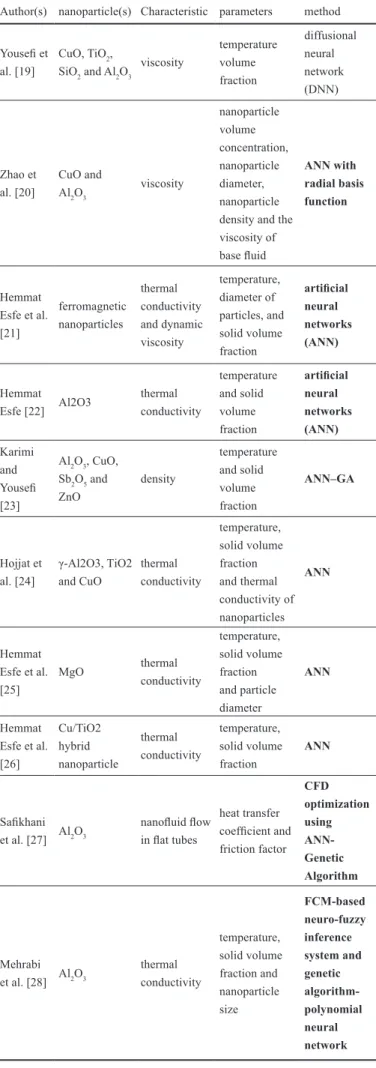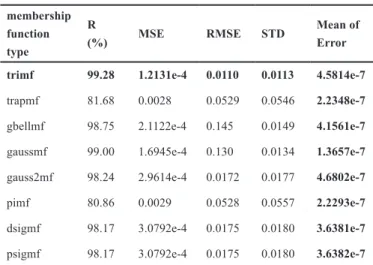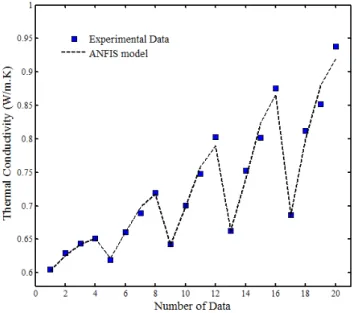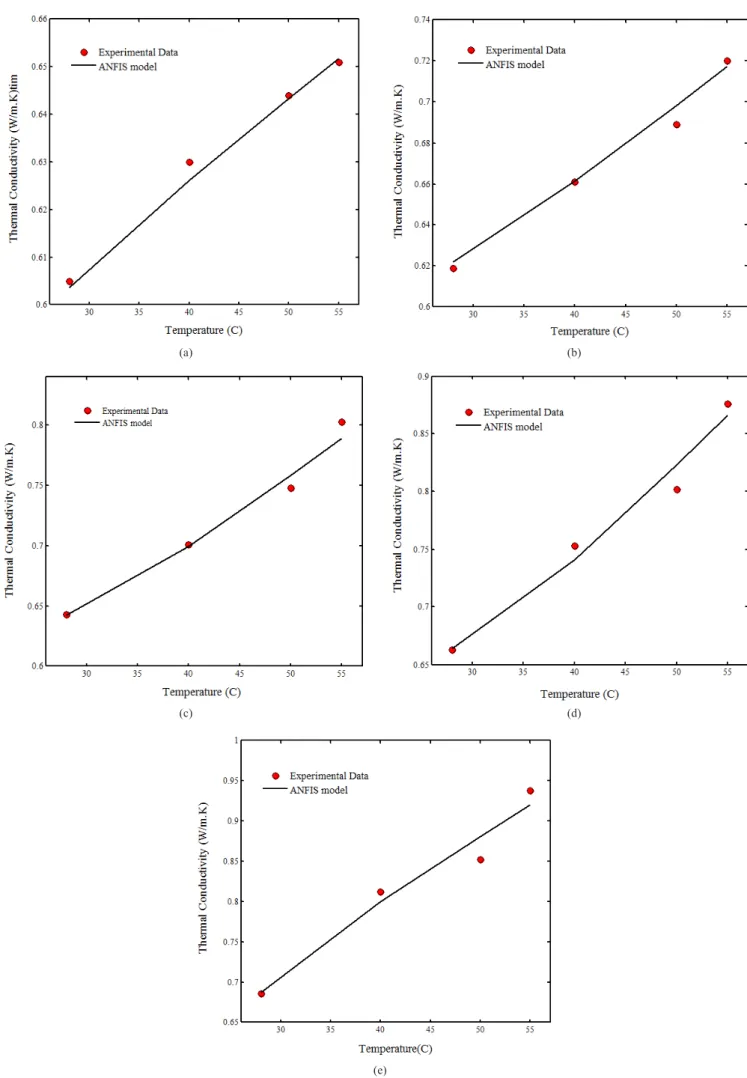Thermal Conductivity Modeling of
Aqueous CuO Nanofluids by Adaptive
Neuro-Fuzzy Inference System
(ANFIS) Using Experimental Data
Mohammad Hemmat Esfe
1*Received 27 June 2016; accepted after revision 14 November 2016
Abstract
In this article, thermal conductivity data of aqueous
nano-fluids of CuO have been modeled through one of the instru
-ments of empirical data modeling. The input data of 5 different
volume fractions of nanofluid obtained in four temperatures
through experiments have been considered as network inputs.
Also, triangular function, due to providing the best responses,
has been used as membership function in ANFIS structure. The
modeling results show that fuzzy networks are able to model
thermal conductivity results of nanofluids with good precision.
Regression coefficient of this modeling has been 0.99.
Keywords
nanofluids, fuzzy networks, thermal conductivity, ANFIS
1 Introduction
Increase in energy cost in long time and growing need for
energy have made scientists look for ways to conserve energy.
One way for conserving energy in heat transfer field is to use
operating fluids of heat transfer with better and more efficient
transfer properties. Around 20 years ago, Choi [1] in his report
proposed his solution for this problem by introducing suspen
-sions called nanofluids. After scientists’ familiarity with these
fluids, a great deal of attention was drawn to them. When many
researchers of heat transfer and mass field observed nanofluids
potential in reducing energy consumption, they embarked on
their researches on these new fluids and thousands of scientific
articles in this field have been published so far.
These articles have different subjects such as nanofluids
thermal conductivity [2-7], viscosity [8-11], heat transfer coef
-ficient [12-18] and the other subjects about nanofluids.
In addition to experimental researches, a large number of
analytical and numerical researches have been conducted on
this field. Beyond this level, some researchers have begun stud
-ies on experimental data modeling. These researches are
con-ducted with the purpose of nanofluids behavior modeling in
thermophysical and hydrodynamic terms.
A report of the studies conducted to model nanofluids behav
-ior is provided in Table 1.
In this article, thermal behavior of aqueous nanofluids con
-taining CuO nanoparticles has been modeled by ANFIS net
-work. The nanofluids were prepared through a two-step method
and the thermal conductivity data were measured based on pre
-vious work [21, 22] in five volume fractions and four tempera
-tures and the modeling results were compared with experimen
-tal data. It should be noted that in this article Sugeno method
has been used for modeling the data through ANFIS network.
Based on the author’s knowledge, there are no similar studies
in literature on modeling the thermal conductivity by Adaptive
Neuro-Fuzzy Inference System (ANFIS).
1 Department of Mechanical Engineering, Imam Hossein University,
Tehran, Iran
* Corresponding author, e-mail: m.hemmatesfe@gmail.com
62(2), pp. 202-208, 2018
https://doi.org/10.3311/PPch.9670
Creative Commons Attribution
b
research article
PP
Periodica Polytechnica
Chemical Engineering
Table 1 Research on modeling the properties of nanofluids method parameters Characteristic nanoparticle(s) Author(s) diffusional neural network (DNN) temperature volume fraction viscosity CuO, TiO2, SiO2 and Al2O3 Yousefi et al. [19] ANN with radial basis function nanoparticle volume concentration, nanoparticle diameter, nanoparticle density and the viscosity of base fluid viscosity CuO and Al2O3 Zhao et al. [20] artificial neural networks (ANN) temperature, diameter of particles, and solid volume fraction thermal conductivity and dynamic viscosity ferromagnetic nanoparticles Hemmat Esfe et al. [21] artificial neural networks (ANN) temperature and solid volume fraction thermal conductivity Al2O3 Hemmat Esfe [22] ANN–GA temperature and solid volume fraction density Al2O3, CuO, Sb2O5 and ZnO Karimi and Yousefi [23] ANN temperature, solid volume fraction and thermal conductivity of nanoparticles thermal conductivity γ-Al2O3, TiO2 and CuO Hojjat et al. [24] ANN temperature, solid volume fraction and particle diameter thermal conductivity MgO Hemmat Esfe et al. [25] ANN temperature, solid volume fraction thermal conductivity Cu/TiO2 hybrid nanoparticle Hemmat Esfe et al. [26] CFD optimization using ANN-Genetic Algorithm heat transfer coefficient and friction factor nanofluid flow in flat tubes Al2O3 Safikhani et al. [27] FCM-based neuro-fuzzy inference system and genetic algorithm-polynomial neural network temperature, solid volume fraction and nanoparticle size thermal conductivity Al2O3 Mehrabi et al. [28]
2 Adaptive Neuro-Fuzzy Inference System
Adaptive Neuro-Fuzzy Inference System or ANFIS is a
category of adaptive networks functioning similar to a fuzzy
inference system, introduced by Jang, which automatically pro
-duces a fuzzy rule base and membership functions [29].
A typical ANFIS network is composed of connected nodes
depending on parameters that are altered by learning rules
reducing the error criteria. The most common learning tech
-nique is the gradient method, but Jang suggested hybrid learn
-ing rule that includes the least Square or LSE Estimator.
There are several different concepts related to ANFIS that
will be explained below [29]:
NUMMFs is the number of membership functions per unit.
In this study, 3 membership functions have been considered per
unit. INPUTMF is the kind of membership function for each
unit. In this research, triangular membership function has been
used for all input membership functions.
OUTPUTMF is the type of output membership function. It
can be linear or constant. The latter has been used as output
membership function in this study.
Neuro-fuzzy systems have a lot in common with artificial
neural networks. However, they also have some differences
from each other. There are four major differences between them:
1. In a neuro-fuzzy system, nodes and links correspond to
a certain component in the system. For instance, First
Layer describes the antecedent MF.
2. A node is generally not completely connected to the
nodes in a neighbouring layer.
3. Nodes in different layers of neuro-fuzzy system usually
perform different tasks.
4. A neuro-fuzzy system usually has more layers than neu
-ral network.
In Fig. 1, the structure of ANFIS network with two inputs
has been shown. For each input, there are three membership
functions. This structure has 9 rules and 9 outputs.
Fig. 1 ANFIS model structure
For a Sugeno type of fuzzy system having the rule base:
If x is A1 and y is B1, then f
1=
p
1x +
q
1y
+
r
1Let the membership functions of fuzzy sets A
i, B
i, i=1,2, be
μ
Ai, μ
Bi.
In evaluating the rules, choose product for T-norm (logical
and).
1. Evaluating the rule premises results in
w
i=
µ
Ai( ) ( )
x
µ
Biy
i
=
1 2
,
2. Evaluating the implication and the rule consequences
gives
f x y
w x y f x y
w x y f x y
w x y
w x y
⋅
(
)
=
(
⋅
)
(
⋅
)
+
(
⋅
)
(
⋅
)
⋅
(
)
+
(
⋅
)
1 1 2 2 1 2Or leaving the arguments out
f x y
w f w f
w w
⋅
(
)
=
+
+
1 1 2 2 1 2This can be separated to phases by first defining
w
w
w w
i
=
+
i1 2
Then f can be written as
f w f w f
=
1 1+
2 2All computations can be presented in a diagram form:
Fig. 2 Computation process of ANFIS
Fig. 3 Computational diagram of ANFIS
Basic flow diagram of computations in ANFIS
The diagrams used as membership functions in ANFIS net
-work have been shown in Fig. 4. These functions have a deter
-mining role in weight values used in empirical data modeling.
Fig. 4 Membership function gallery
In order to model the data by ANFIS, different membership
functions have been used. A list of these membership functions
as well as regression parameters has been provided in Table 2.
The best response has been obtained from membership func
-tion of
trimf or triangular membership function. In this table,
MSE is Mean Squared Error, RMSE is square root of MSE, and
STD is standard deviation of responses from empirical values.
Table 2 Regression parameters
Mean of Error STD RMSE MSE R (%) membership function type 4.5814e-7 0.0113 0.0110 1.2131e-4 99.28 trimf 2.2348e-7 0.0546 0.0529 0.0028 81.68 trapmf 4.1561e-7 0.0149 0.145 2.1122e-4 98.75 gbellmf 1.3657e-7 0.0134 0.130 1.6945e-4 99.00 gaussmf 4.6802e-7 0.0177 0.0172 2.9614e-4 98.24 gauss2mf 2.2293e-7 0.0557 0.0528 0.0029 80.86 pimf 3.6381e-7 0.0180 0.0175 3.0792e-4 98.17 dsigmf 3.6382e-7 0.0180 0.0175 3.0792e-4 98.17 psigmf
After modeling the data, experimental values can be com
-pared with output values of ANFIS modeling. This comparison
has been shown in Fig. 5. As is observed in this figure, the
model could estimate the experimental data with good preci
-sion. Therefore, we realize that ANFIS can be a proper tool for
modeling nanofluids thermal conductivity.
(1)
(2)
(3)
(4)
Fig. 5 Comparison between experimental data and ANFIS model
In Fig. 6, the histogram of modeling error has been shown.
This diagram divides modeling error into five intervals and
specifies the number of samples in each interval in vertical
bars. If the modeling error is low, the number of samples in the
interval close to zero is bigger. The curve in this diagram also
shows that most of the data have an error close to zero.
The following relation can be used to obtain margin of devi
-ation of ANFIS output:
MOD
k
k
k
exp pred exp%
( )
=
−
×
100
This equation yields the percentage of modeling error. The
values obtained from this equation have been shown in Fig. 7.
The maximum error for this modeling has been less than 4%
that is considered an acceptable value for this modeling.
Fig. 6 Margin of deviation
Fig. 7 Comparison between experimental data and ANFIS model
In Fig. 8, modeling results at different volume fractions of
nanoparticles in nanofluids have been compared with experi
-mental data. In this article, experi-mental data of 4 volume frac
-tions of 0.04%, 0.08%, 0.12%, and 0.16% as well as base fluid
have been used. It is seen in this figure that modeling the data
could estimate the experimental data with good precision.
Considering the data in these diagrams reveals that increase
in thermal conductivity of base fluid from 28 to 55°C has been
just 7% and increased from 0.605 to 0.65 W/m.K while increase
in thermal conductivity of nanofluids with volume fraction of
0.16% has been 38% and increased from 0.68 to 0.94 W/m.K.
The parameters of the nonlinear regression have been pro
-vided in Table 3:
Table 3 Parameters of the nonlinear regression
mean of error RMSE MSE R 8.9000e-4 0.0119 1.4158e-4 0.9918
By considering the results provided in Table 3 and Fig. 6,
we conclude that the conducted modeling has been very suc
-cessful and these networks can be used for modeling more
extensive data and for different properties of nanofluids. The
closer R
2value to 1 shows the better prediction of experimental
data by the proposed model [30]. As can be seen from Table 3,
R-squared is 0.9918.
3 Conclusions
The assessment of possibility of using adaptive neuro-fuzzy
inference systems (ANFIS) for modeling experimental data of
CuO nanofluids thermal conductivity was investigated in this
article. For this purpose, a number of experimental data of ther
-mal conductivity of CuO-water nanofluids are given to network
as input and the modeling is conducted by determining the appro
-priate type of network structure and also membership function.
(6)
(a) (b)
(c) (d)
(e)
The results show that these networks can model with good pre
-cision. Therefore, these networks can also be introduced as an
instrument for post-processing the nanofluids experimental data.
References
[1] Choi, S. U. S. "Enhancing thermal conductivity of fluids with nanoparti
-cle." ASME FED. 231, pp. 99–105. 1995.
[2] Hemmat Esfe, M., Karimipour, A., Yan, W.-M., Akbari, M., Safaei, M. R., Dahari, M. "Experimental study on thermal conductivity of ethylene glycol based nanofluids containing Al2O3 nanoparticles." International
Journal of Heat and Mass Transfer. 88, pp. 728–734. 2015.
https://doi.org/10.1016/j.ijheatmasstransfer.2015.05.010
[3] Hemmat Esfe, M., Saedodin, S., Akbari, M., Karimipour, A., Afrand, M., Wongwises, S., Safaei, M. R., Dahari, M. "Experimental investigation and development of new correlations for thermal conductivity of CuO/ EG–water nanofluid." International Communications in Heat and Mass Transfer. 65, pp. 47–51. 2015.
https://doi.org/10.1016/j.icheatmasstransfer.2015.04.006
[4] Karami, M., Akhavan-Behabadi, M. A., Raisee Dehkordi, M., Delfani, S. "Thermo-optical properties of copper oxide nanofluids for direct absorp
-tion of solar radia-tion." Solar Energy Materials and Solar Cells. 144, pp. 136–142. 2016. https://doi.org/10.1016/j.solmat.2015.08.018
[5] Hemmat Esfe, M., Saedodin, S., Asadi, A., Karimipour, A. "Thermal conductivity and viscosity of Mg (OH) 2-ethylene glycol nanofluids."
Journal of Thermal Analysis and Calorimetry. 120(2), pp. 1145–1149. 2015. https://doi.org/10.1007/s10973-015-4417-3
[6] Hemmat Esfe, M., Saedodin, S., Mahian, O., Wongwises, S. "Thermal conductivity of Al2O3/water nanofluids." Journal of Thermal Analysis and Calorimetry. 117(2), pp. 675-681. 2014.
https://doi.org/10.1007/s10973-014-3771-x
[7] Salari, E., Peyghambarzadeh, S. M., Sarafraz, M. M., Hormozi, F. "Boil
-ing Thermal Performance of TiO2 Aqueous NanoFluids as a Coolant on a Disc Copper Block." Periodica Polytechnica Chemical Engineering.
60(2), pp. 106-122. 2016.
https://doi.org/10.3311/PPch.8262
[8] Goharkhah, M., Ashjaee, M., Jamali, J. "Experimental investigation on heat transfer and hydrodynamic behavior of magnetite nanofluid flow in a channel with recognition of the best models for transport properties."
Experimental Thermal and Fluid Science. 68, pp. 582–592. 2015.
https://doi.org/10.1016/j.expthermflusci.2015.05.013
[9] Hemmat Esfe, M., Saedodin, S., Wongwises, S., Toghraie, D. "An ex
-perimental study on the effect of diameter on thermal conductivity and dynamic viscosity of Fe/water nanofluids." Journal of Thermal Analysis and Calorimetry. 119(3), pp. 1817–1824. 2015.
https://doi.org/10.1007/s10973-014-4328-8
[10] Baheri Islami, S., Dastvareh, B., Gharraei, R. "An investigation on the hydrodynamic and heat transfer of nanofluid flow, with non-Newtonian base fluid, in micromixers." International Journal of Heat and Mass Transfer. 78, pp. 917–929. 2014.
https://doi.org/10.1016/j.ijheatmasstransfer.2014.07.022
[11] Hemmat Esfe, M., Saedodin, S., Naderi, A., Alirezaie, A., Karimipour, A., Wongwises, S., Goodarzi, M., bin Dahari, M. "Modeling of thermal con
-ductivity of ZnO-EG using experimental data and ANN methods."
Interna-tional Communications in Heat and Mass Transfer. 63, pp. 35–40. 2015.
https://doi.org/10.1016/j.icheatmasstransfer.2015.01.001
[12] Hemmat Esfe, M., Saedodin, S., Mahian, O., Wongwises, S. "Thermo
-physical properties, heat transfer and pressure drop of COOH-function
-alized multi walled carbon nanotubes/water nanofluids." International
Communications in Heat and Mass Transfer. 58, pp. 176–183. 2014.
https://doi.org/10.1016/j.icheatmasstransfer.2014.08.037
[13] Azmi, W. H., Sharma, K. V., Sarma, P. K., Mamat, R., Anuar, S., Syam Sundar, L. "Numerical validation of experimental heat transfer coeffi
-cient with SiO2 nanofluid flowing in a tube with twisted tape inserts."
Applied Thermal Engineering. 73(1), pp. 296–306. 2014.
https://doi.org/10.1016/j.applthermaleng.2014.07.060
[14] Hemmat Esfe, M., Saedodin, S., Mahian, O., Wongwises, S., Hemmat, M., Saedodin, S., Mahian, O., Wongwises, S. "Efficiency of ferromagnetic na
-noparticles suspended in ethylene glycol for applications in energy devices: Effects of particle size, temperature, and concentration." International
Communications in Heat and Mass Transfer. 58, pp. 138–146. 2014.
https://doi.org/10.1016/j.icheatmasstransfer.2014.08.035
[15] Abbasian Arani, A. A., Amani, J., Hemmat Esfe, M. "Numerical simula
-tion of mixed convec-tion flows in asquare double lid-driven cavity partially heated using nanofluid." Journal of Nanostructure. 2, pp. 301-311. 2012.
https://doi.org/10.7508/jns.2012.03.005
[16] Reddy, M. C. S., Rao, V. V. "Experimental investigation of heat transfer coefficient and friction factor of ethylene glycol water based TiO2 nanofluid in double pipe heat exchanger with and without helical coil inserts."
Inter-national Communications in Heat and Mass Transfer. 50, pp. 68–76. 2014.
https://doi.org/10.1016/j.icheatmasstransfer.2013.11.002
[17] Shoghl, S. N., Bahrami, M. "Experimental investigation on pool boil
-ing heat transfer of ZnO, and CuO water-based nanofluids and effect of surfactant on heat transfer coefficient." International Communications in Heat and Mass Transfer. 45, pp. 122–129. 2013.
https://doi.org/10.1016/j.icheatmasstransfer.2013.04.015
[18] Hemmat Esfe, M., Saedodin, S., Mahian, O., Wongwises, S. "Heat trans
-fer characteristics and pressure drop of COOH-functionalized DWCNTs/ water nanofluid in turbulent flow at low concentrations." International
Journal of Heat and Mass Transfer. 73, pp. 186–194. 2014.
https://doi.org/10.1016/j.ijheatmasstransfer.2014.01.069
[19] Yousefi, F., Karimi, H., Papari, M. M. "Modeling viscosity of nanofluids using diffusional neural networks." Journal of Molecular Liquids. 175, pp. 85–90. 2012.
https://doi.org/10.1016/j.molliq.2012.08.015
[20] Zhao, N., Wen, X., Yang, J., Li, S., Wang, Z. "Modeling and prediction of viscosity of water-based nanofluids by radial basis function neural networks." Powder Technology. 281, pp. 173–183. 2015.
https://doi.org/10.1016/j.powtec.2015.04.058
[21] Hemmat Esfe, M., Saedodin, S., Sina, N., Afrand, M. "Designing an artificial neural network to predict thermal conductivity and dynamic viscosity of ferromagnetic nanofluid." International Communications in Heat and Mass Transfer. 68, pp. 50–57. 2015.
https://doi.org/10.1016/j.icheatmasstransfer.2015.06.013
[22] Hemmat Esfe, M., Afrand, M., Yan, W.-M., Akbari, M. "Applicability of artificial neural network and nonlinear regression to predict thermal conductivity modeling of Al2O3–water nanofluids using experimental data." International Communications in Heat and Mass Transfer. 66, pp. 246–249. 2015.
https://doi.org/10.1016/j.icheatmasstransfer.2015.06.002
[23] Karimi, H., Yousefi, F. "Application of artificial neural network–genetic algorithm (ANN–GA) to correlation of density in nanofluids." Fluid Phase Equilibria. 336, pp. 79–83. 2012.
https://doi.org/10.1016/j.fluid.2012.08.019
[24] Hojjat, M., Etemad, S. G. G., Bagheri, R., Thibault, J. "Thermal con
-ductivity of non-Newtonian nanofluids: Experimental data and modeling using neural network." International Journal of Heat and Mass Transfer.
54(5–6), pp. 1017–1023. 2011.
[25] Hemmat Esfe, M., Bahiraei, M., Mahian, O., Saedodin, S., Bahiraei, M., Toghraie, D., Mahian, O., Wongwises, S. "Thermal conductivity modeling of MgO/ EG nanofluids using experimental data and artificial neural network." Journal of Thermal Analysis and Calorimetry. 118(1), pp. 287–294. 2014.
https://doi.org/10.1007/s10973-014-4002-1
[26] Hemmat Esfe, M., Wongwises, S., Naderi, A., Asadi, A., Safaei, M. R., Rostamian, H., Dahari, M., Karimipour, A. "Thermal conductivity of Cu/ TiO2–water/EG hybrid nanofluid: Experimental data and modeling us
-ing artificial neural network and correlation." International Communica
-tions in Heat and Mass Transfer. 66, pp. 100-104. 2015.
https://doi.org/10.1016/j.icheatmasstransfer.2015.05.014
[27] Safikhani, H., Abbassi, A., Khalkhali, A., Kalteh, M. "Multi-objective optimization of nanofluid flow in flat tubes using CFD, Artificial Neural Networks and genetic algorithms." Advanced Powder Technology. 25(5), pp. 1608–1617. 2014.
https://doi.org/10.1016/j.apt.2014.05.014
[28] Mehrabi, M., Sharifpur, M., Meyer, J. P. "Application of the FCM-based neuro-fuzzy inference system and genetic algorithm-polynomial neural network approaches to modelling the thermal conductivity of alumina– water nanofluids." International Communications in Heat and Mass Transfer. 39(7), pp. 971–977. 2012.
https://doi.org/10.1016/j.icheatmasstransfer.2012.05.017
[29] Jang, J.-S. R. "ANFIS: adaptive-network-based fuzzy inference sys
-tem." IEEE Transactions on Systems, Man, and Cybernetics. 23(3), pp. 665–685. 1993.
https://doi.org/10.1109/21.256541
[30] Rostamian, H., Lotfollahi, M. N. "New Functionality for Energy Param
-eter of Redlich-Kwong Equation of State for Density Calculation of Pure Carbon Dioxide and Ethane in Liquid, Vapor and Supercritical Phases."
Periodica Polytechnica Chemical Engineering. (60)2, pp. 93-97. 2016.



